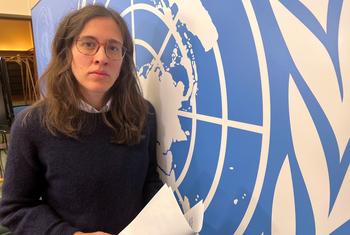Refugee agency appeals for $137 million to help displaced in Horn of Africa

Lifesaving aid is needed urgently to help millions of people enduring one of the longest and most severe droughts on record in the Horn of Africa, the UN refugee agency, UNHCR, said on Tuesday, as the region enters its sixth consecutive rainy season with no rain.
Today in Somalia, Ethiopia and Kenya, more than eight million people require food assistance and around 332,000 “urgently need food, otherwise their lives are at risk”, said UNHCR spokesperson Olga Sarrado.
A full eight in 10 of the displaced are women and children, the UNHCR official continued, while UN migration agency, IOM, warned that failed rains and conflict in Somalia, “could force tens of thousands of people" to seek refuge in major cities and towns, particularly in Baidoa and Mogadishu where IOM projects that approximately 300,000 people could be newly displaced by July 2023”.
In an appeal for $137 million to maintain vital humanitarian programmes this year, UNHCR’s Ms. Sarrado said that well over three million refugees and internally displaced people have already been forced to leave their homes in Somalia, Ethiopia and Kenya.
Climate Change
Conflict
Displacement
Shamsa and her family are now safe in Dadaab refugee camp after fleeing drought. But there are millions of others in the region who are facing this same deadly mix. https://t.co/jYFPAF7xf8
RefugeesStruggle to survive
Survival is a struggle for these uprooted communities, amid scarce water sources, hunger, insecurity and conflict. They need safety and assistance, just as much as host communities do too, the UN agency insisted.
“While famine has so far been averted in Somalia, mostly due to a stepped-up humanitarian response, people continue to battle life-threatening food and water shortages resulting from massive losses of harvests, livestock, and income,” Ms. Sarrado explained.
Price to pay
The UNHCR spokesperson warned however that prices of essential foodstuffs and other commodities “remain at an all-time high, out of reach for many. The dangerous confluence of climate and conflict in the region is worsening an already dire humanitarian situation.”
In Somalia alone, since the start of the year, 288,000 people have become internally displaced, because of conflict and drought, UNHCR data shows.
More than 180,000 refugees from Somalia and South Sudan have also crossed into drought-affected areas of Kenya and Ethiopia, the UN agency noted.
In Ethiopia’s Somali region – itself already suffering deeply from drought – nearly 100,000 people have arrived in Doolo in recent weeks, after fleeing conflict in the Somalia’s Laascaanood area.
Desperate testimony
In Kenya’s Dadaab camps, UNHCR also reported the testimony of a 60-year-old woman from Somalia who said that she had endured three decades of conflict in southern Somalia, but that it was extreme hunger that forced her to flee for her life.
“Most of the newly displaced might never go back to their places of origin because the land can no longer provide, and insecurity will only increase as competition for the already scarce resources grow,” IOM said in an alert for the record 3.8 million people now displaced in Somalia. “As a result, entire families will be born and raised in informal settlements amid unsuitable living conditions.”
Humanitarian action
As part of its response, UNHCR plans to provide more basic relief items including emergency shelter and household items for new refugee arrivals and displaced people in Somalia, Ethiopia and Kenya.

Water trucking supplies will be increased, while additional boreholes will be drilled and existing water and sanitation systems refurbished.
Cash assistance will be prioritized for the most vulnerable to help them supplement their own food needs, while also encouraging traders to make food and other necessities available.
Health facilities will also be supported to step up nutritional assistance for women and children through high-nutrient feeding and medical treatment for related diseases.
“This additional assistance and protection is required urgently…to save millions of lives,” said UNHCR’s Ms. Sarrado, who noted that last year’s appeal garnered less than half of the required amount needed to respond to the drought.
© UN News (2023) — All Rights ReservedOriginal source: UN News
 Global Issues
Global Issues